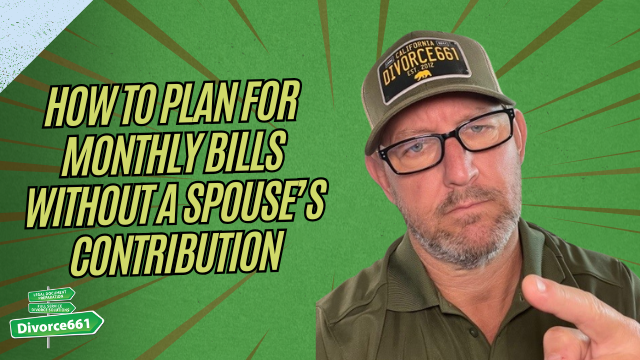How to Plan for Monthly Bills Without a Spouse’s Contribution
I’m Tim Blankenship with Divorce661. Going from two incomes to one after a separation or divorce is one of the biggest financial shifts you can face. It can feel overwhelming, but with a clear plan you can take control of your monthly bills, protect your cash flow, and move forward with confidence.
Why a plan matters
When you’re suddenly responsible for the entire household budget, uncertainty creates stress. A simple, realistic plan turns that stress into manageable action. By understanding exactly what you owe, what you earn, and where you can reasonably adjust, you’ll create stability and preserve your lifestyle while you adapt.
Step 1 — List every fixed monthly expense
Start by writing down all recurring totals you pay each month. Be thorough. Include items that are often forgotten.
- Rent or mortgage
- Utilities (electricity, gas, water)
- Car payments and fuel
- Insurance (auto, home/renters, health)
- Internet and phone
- Childcare, tuition, or school-related costs
- Debt payments (credit cards, personal loans)
- Subscriptions and memberships (streaming services, gyms)
- Child support or alimony payments (if applicable)
- Groceries and basic household supplies
Step 2 — Map out your monthly income
List all reliable income sources: your paycheck (after taxes), freelance or side income, child support, alimony, investment distributions, and any other funds you can count on. The goal is a realistic monthly net income number — the cash that actually hits your account.
Step 3 — Identify the gap and prioritize
Subtract total expenses from your net income. If there’s a shortfall, identify must-have expenses versus “nice-to-haves.” Prioritize shelter, utilities, food, transportation, and insurance. Discretionary spending can be adjusted temporarily while you stabilize.
Prioritization checklist
- Essentials first: housing, utilities, food, insurance
- Necessary transportation and childcare
- Minimum debt payments to avoid penalties and credit damage
- Discretionary items to reduce or pause
Step 4 — Practical ways to reduce expenses without major sacrifice
It’s not about cutting everything you enjoy. It’s about getting lean and efficient with your money while you adjust.
- Review insurance policies — switching plans or adjusting coverage can lower premiums.
- Pause or cancel unused streaming and subscription services.
- Meal plan and cook at home more often instead of eating out.
- Shop for cheaper phone or internet plans; providers often have competitive offers for new customers.
- Refinance a car loan or mortgage if interest rates and terms make sense.
- Negotiate bills — many service providers will work with you if you explain your situation.
- Consolidate or refinance high-interest debt to reduce monthly payments.
- Create a monthly grocery and household budget and track it for one to two months to find easy wins.
“It’s not about cutting everything you enjoy. It’s about getting lean and efficient with your money while you adjust.”
Real-life example — small changes, big impact
We helped a client who suddenly had to manage the full household budget on her own. By making a few targeted changes — adjusting her auto insurance, pausing some streaming services, and meal planning instead of eating out — she freed up over $400 a month without sacrificing her lifestyle. Those kinds of gains add up quickly and provide breathing room while you transition.
When savings aren’t enough — restructure and protect cash flow
If trimming expenses still leaves a gap, consider options to change how you pay rather than what you pay:
- Refinance loans to lower monthly payments.
- Ask creditors for temporary hardship plans or modified payment schedules.
- Set up an emergency reserve to handle uneven months.
- Explore additional income streams (part-time work, freelancing) as a bridge.
Next steps — build a budget that works for you
Take these actions this week:
- Write down all monthly bills and their due dates.
- Calculate your net monthly income.
- Highlight essentials and cut or pause the low-value items.
- Contact service providers to look for savings opportunities.
- Revisit your plan monthly and adjust as your situation changes.
Get help if you need it
Managing finances after divorce isn’t just about numbers — it’s about gaining clarity and confidence. At Divorce661, we guide clients through the day-to-day financial planning that follows a divorce so they can move forward with stability. If you’d like help organizing your budget and protecting your cash flow, visit Divorce661.com to schedule a free consultation.
Final thought
Transitioning to a single income is challenging, but it’s manageable. With a clear list of expenses, a realistic income map, and a few strategic adjustments, you can stabilize your monthly budget and protect your future.




